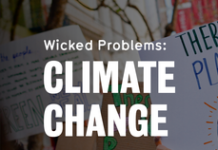In the next five to ten years, the Waterloo Region will experience increased warming and extreme heat events, heavy precipitation with risk of flooding, and be affected by wildfire smoke travelling thousands of kilometres across the country. What does this mean for UW, and how do students, staff, and faculty have a responsibility to ensure a climate-safe future for all?
“The need to adapt to climate change impacts is urgent,” said Caroline Metz, managing director of climate resilience and health at the Intact Centre on Climate Adaptation. “Adaptation will need to continue as our climate continues to warm, and the threats evolve. Solutions exist for how to reduce risks from extreme weather. Investing today and putting these solutions in place now, can save money, lives and health costs, by avoiding future damages and losses.”
The Intact Centre is located in the faculty of environment at UW. “It is an applied research centre dedicated to climate adaptation — 100 per cent focus on adapting to the impacts of a warming climate — and building a more resilient country. We develop guidance, standards and tools that can be used by various stakeholders to reduce physical risks from climate change and extreme weather,” Metz explained. The Intact Centre looks ahead to manage risks well before weather events and help minimize disasters, ensuring people and communities remain safe and “works to address risks associated with the three most financially and socially costly extreme weather hazards in Canada — flooding, wildfire and extreme heat.”
“The University of Waterloo lies in the Grand River watershed, with the waterways Columbia Lake, Laurel Creek, and Laurel Lake passing through campus. The Grand River itself flows through the municipalities of Waterloo and Kitchener,” Metz said.
Flooding can cause infrastructure damage, impact commute to class, public transportation operation, and accessibility of spaces. On campus, Laurel Creek is on the path of many students’ trips to class. It is also used for labs with ecology students and others venturing into the creek for sampling and data collection.
The Grand River Conservation Authority (GRCA) manages water levels and flood risk within the region and has a multitude of flooding resources, for warning and preparedness.
“Much of our flooding issues are related to rapid snowmelt, which may be accompanied by heavy rainfall in the months of January through March,” said Mark Anderson, senior engineer in flood management at GRCA. “There are two flood-related issues that we believe are related to climate change. The first is more frequent mid-winter snowmelt events, where snow accumulates early in the winter and then melts quickly when temperatures rise quickly above zero. The second is ice jam flooding, which can happen when we experience back to back freeze-thaw cycles where thick ice forms, breaks up and moves downstream then refreezes.”
The GRCA observed this behaviour in February 2018 when it caused significant flooding in the city of Brantford. The ice jam flooding led to over 2000 homes evacuated, with homeowners facing thousands of dollars in damage, once they were able to return.
Flood occurrences in the Waterloo Region include Feb. 4, 2019 at Huron Road in Kitchener where it crosses Schneider Creek and Jan. 13, 2020 in the village of Ayr. In these cases large amounts of debris, such as branches and full trees, were washed into the river, prompting the GRCA to advise residents to stay away from waterways well after the flood event, as it was unsafe to access them. Several roadways were shut down during these floods, the 2020 flood reached Warning Zone Level 3, stopping at the lower threshold of this warning, just before homes are flooded directly. Damage is both environmental and financial with homes, roadways and greenspaces affected by floods.
Flooding is always a concern when businesses and residences are built on floodplains.
“Flooding on campus from heavy precipitation will remain a significant risk for the future, given that heavy downpours are occurring more frequently and intensely as our climate continues to warm,” Metz said.
Mentioned in the 2023 Sustainability Report, the Sustainable Land Care Standard was first drafted by the UW Sustainability Office in 2022. Water management is one of the seven focus areas the standard covers, with “[u]tilize green infrastructure in flood-prone areas” stated as one of the water management key points.
Natural solutions and engineered examples are provided in the standard as green infrastructure options that will help slow down movement of water during rainfall events, as well as increase absorption capacity of greenspaces.
“We have built out numerous features across the campus, including storm ponds, naturalized spaces, and permeable pavement, that improve water retention and reduce flood risk. We are also supporting stream and ecological restoration projects along the Laurel Creek corridor that can also manage potential flooding.” said Mat Thijssen, director of sustainability at UW. “We do know the risk of flooding over time will increase, so we are working through identifying areas in need of future prioritization for green infrastructure.”
Other risks are also present on campus, such as extreme heat. Greenspaces can play a role in cooling campus spaces, and are one outdoor solution.
“Risks from extreme heat can also be managed through behavioural and planning actions, and green and grey infrastructure actions. Residents, tenants (including UW students), and property owners and managers within the UW community can take action to reduce risks,” Metz said.
In the first article of this series, residence infrastructure was examined with a focus on extreme heat concerns. Progress is being made towards infrastructure updates that mitigate heat risks in campus housing residences.
The Intact Centre has developed guidance on how to manage flood and extreme heat risk. A variety of infographics can be found on their website, such as the “Apartment and Condo Heat Protection” infographic which can be of use to students on and off campus.
Comparing climate data from 1976-2005 to future projections for 2051-2080, the Intact Centre’s report “Irreversible Extreme Heat” concluded that several Canadian cities in the area north of Lake Erie, from Windsor to Toronto (and further east) will experience high heat conditions. Metz summarized, “For Kitchener-Waterloo, the number of ‘very hot days (above 30 °C)’ is expected to go from 10 to about 54 days by mid-century (2051-2080). The ‘warmest maximum temperature’ is expected to go from 33 °C to about 37.5 °C (by 2051-2080), and the ‘average length of heat waves’ will go from three to about seven-and-a-half days (by 2051-2080).”
Every action we take today has an impact on future climate outcomes. 2051, although seemingly distant, is closer to us through our everyday choices. Imagine picking up today in the timeline and picking up the same day in 2051 and folding the two together like corners of a napkin. Aligned, the effect of days in the present on days in the future is clear. With regards to extreme weather events, rising temperatures, and increased flood risks, ask why is this happening? What is driving climate change in my location and what steps can we take to increase climate change literacy and preparedness while decreasing climate change causes?
Ask yourself, what kind of climate future do you want to live in?






























